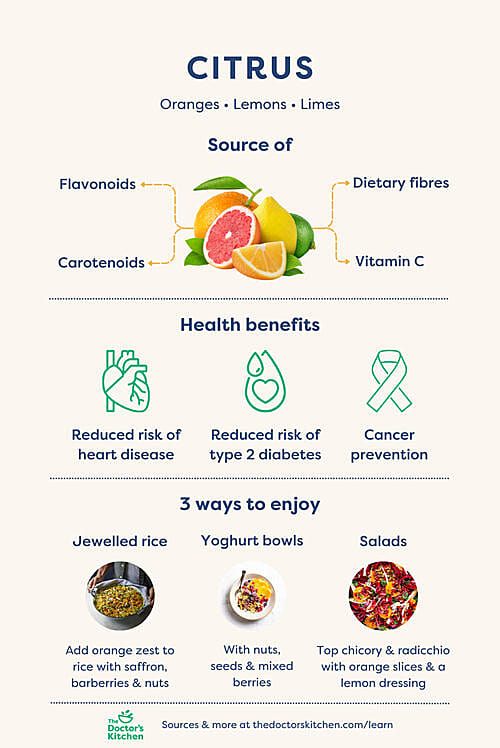Citrus: Great fruits for heart health
16th Feb 2024
Oranges, grapefruits and lemons are bursting with vitamin C, flavonoids and fibre, improving heart health, cholesterol and inflammation. Add them to salads, marinades and snacks!
Key points
In a nutshell

Key nutrients in citrus
They are rich in essential nutrients and plant compounds, including:
- Flavonoids, such as hesperidin and naringin
- Carotenoids
- Dietary fibre, such as pectin
- Potassium and vitamin C
Health benefits of citrus fruits
Research shows that eating citrus fruits regularly is linked to:
1. 🫀 Heart health
Regular citrus intake has been linked to lower cholesterol levels and blood pressure, reducing the risk of heart disease and stroke. Grapefruit seems to have an extra edge in supporting heart health.
2. 🩸 Lower risk of type 2 diabetes
Eating citrus fruits regularly may help improve fasting glucose, reduce insulin resistance and lower the risk of type 2 diabetes. These benefits, linked to their flavonoids and vitamin C, may build over time by reducing inflammation and supporting gut health.
3. ⚖️ Weight control
Studies suggest citrus fruits or their extracts may aid weight loss, with small reductions in body weight, BMI and waist size after at least 4 weeks. These effects are likely thanks to active compounds that support metabolism and reduce inflammation. While subtle, they can still be part of a balanced approach to managing weight.
4. 🤧 Immune support
They might also support your immune system with vitamin C and flavonoids, which have antiviral and antioxidant effects. Studies show that higher flavonoid intake (0.2 to 1.2 g/day) could lower the risk of upper respiratory infections by 33% and reduce sick days by 40%.
5. 📉 Cancer prevention
Cohort studies show that eating citrus fruits regularly is linked to a 13% lower risk of gastric cancer, with 100g a day reducing the risk by up to 40%. Compounds like hesperidin may help by protecting cells, reducing inflammation and supporting cancer-fighting pathways, making citrus a smart choice for prevention.
How much?
Studies found benefits ranging from 4 times per week to 100g per day. One portion (80g) is 1 medium orange, 1 medium mandarin orange or half a grapefruit.
Important note
Grapefruit juice can interact with certain medications, including those for high blood pressure and coronary heart disease. If you're on medication, consult your pharmacist or doctor for advice.
Where do citrus fruits come from?
They are believed to have originated in Southeast Asia, with plant fossils in Yunnan, China, dating back 8 million years. But some researchers suggest citrus may be even older, emerging over 25 million years ago on the Indian subcontinent as it collided with Asia to form the Himalayas.
Traditional uses
For centuries, citrus fruits and their peels have been trusted remedies for indigestion, coughs, skin issues, muscle pain and even lowering blood pressure. The Chinese Pharmacopoeia highlights nine medicinal uses across six citrus species, showing their deep roots in traditional medicine.
3 ways to enjoy
Citrus fruits are available year-round, but they truly shine in the winter months. Their vibrant colours, bright flavours and zingy acidity elevate both savoury and sweet dishes. Here are a few of our favourite ways to enjoy them:
- Zesty Marinades – Use citrus juice with spices, honey and olive oil to marinate fish.
- Toppings – Add orange or grapefruit to yoghurt or porridge with nuts, seeds and berries.
- Fresh Salads – Toss citrus pieces into salads with greens, chicory, nuts and your favourite dressing.
References/sources
Health benefits – Cheng et al. Journal of Nutritional Oncology. 2023
History – Wu et al. Nature. 2018 | Scientific American
